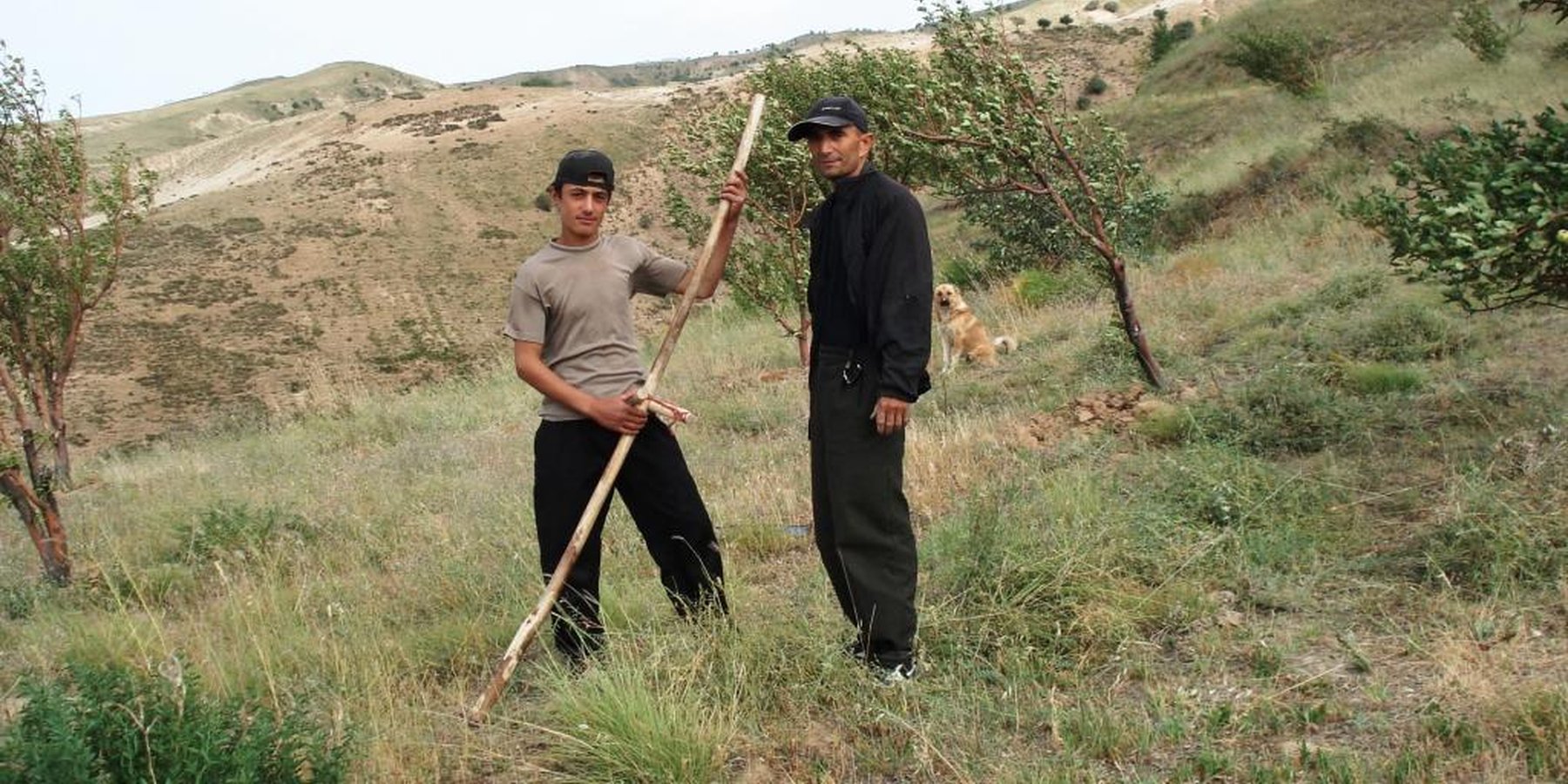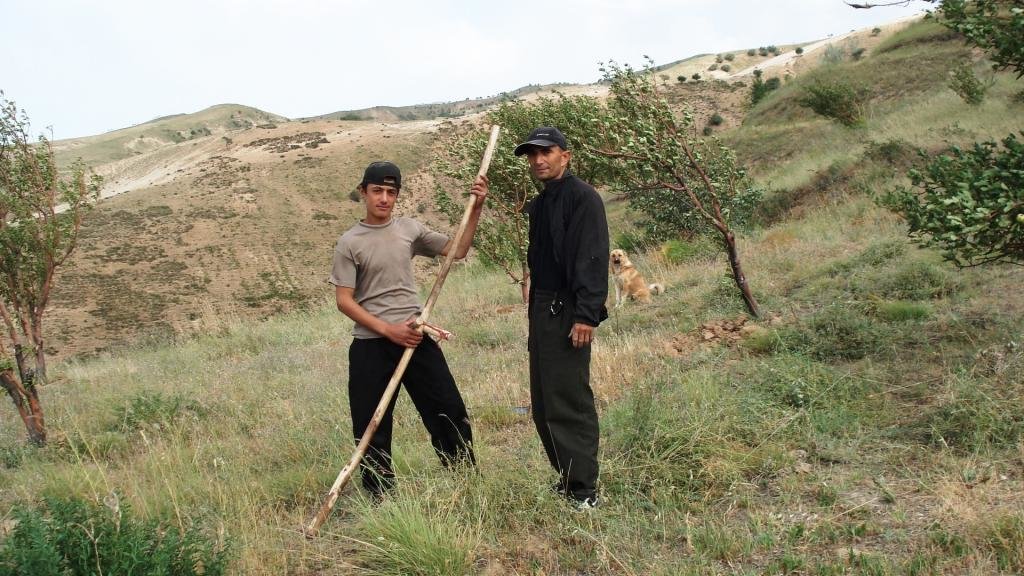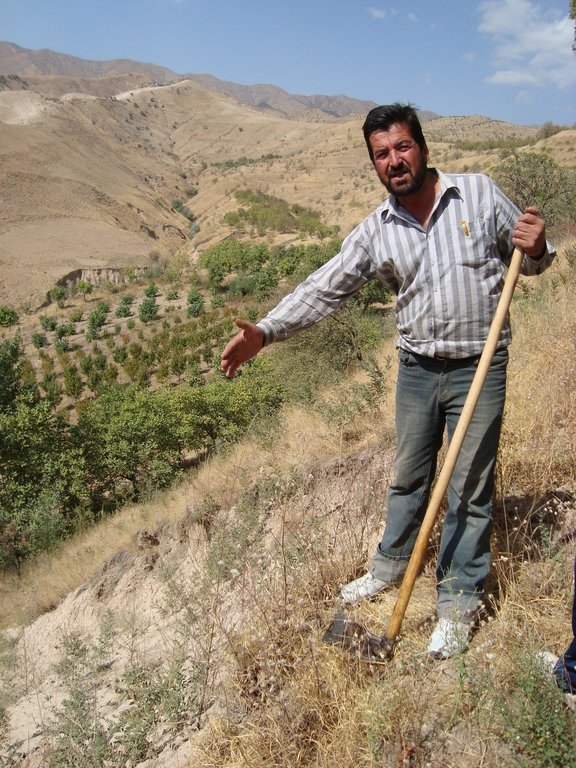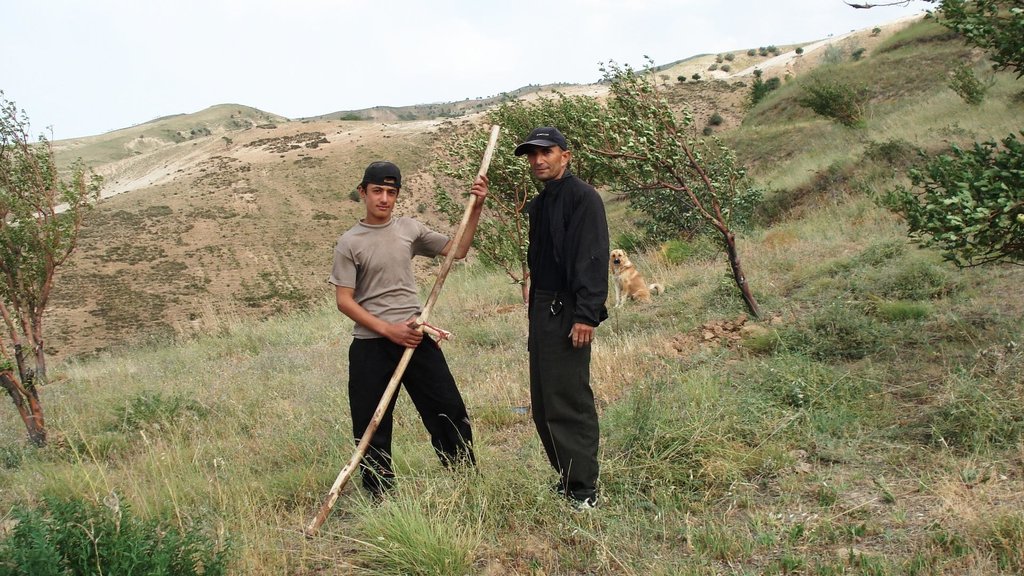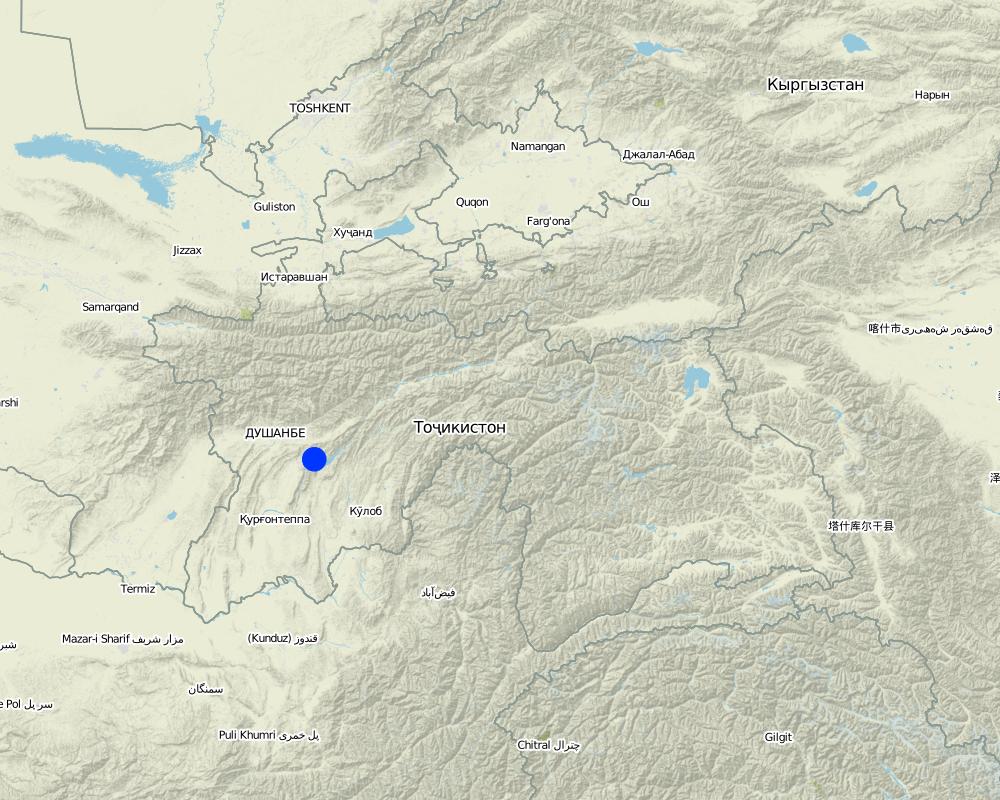State-controlled research territory for orcharding [Tadjikistan]
- Création :
- Mise à jour :
- Compilateur : Christian Wirz
- Rédacteur : –
- Examinateur : David Streiff
approaches_2566 - Tadjikistan
Voir les sections
Développer tout Réduire tout1. Informations générales
1.2 Coordonnées des personnes-ressources et des institutions impliquées dans l'évaluation et la documentation de l'Approche
Nom du ou des institutions qui ont facilité la documentation/ l'évaluation de l'Approche (si pertinent)
CDE Centre for Development and Environment (CDE Centre for Development and Environment) - Suisse1.3 Conditions relatives à l'utilisation par WOCAT des données documentées
Quand les données ont-elles été compilées (sur le terrain)?
20/08/2008
Le compilateur et la(les) personne(s) ressource(s) acceptent les conditions relatives à l'utilisation par WOCAT des données documentées:
Oui
1.4 Références au(x) questionnaire(s) sur les Technologies de GDT

Combined cut-and-carry and fruit-production system with terraces [Tadjikistan]
A combination of fruit- and nut-trees together with seminatural trees and shrubs on one side with grass-communities on the other side provide for a diversified production system.
- Compilateur : Christian Wirz
2. Description de l'Approche de GDT
2.1 Courte description de l'Approche
Cultivation of an orchard with research activities and research staff with food for work.
2.2 Description détaillée de l'Approche
Description détaillée de l'Approche:
Aims / objectives: The main objective is to dispose of varieties of fruits that are adapted to different conditions. Another objective is to prevent degradation and test methods of rehabilitation and to spread this knowledge. The orchard was also implemented as a source of labour for 50 employees. In the last years it has become more important to acquire self-sufficiency by fruit- and hay-production, because wages cannot always be paid. And because of limited state-support in terms of fertilisers, pesticides and machines, the selling of tree saplings is important.
Methods: Work is subdivided into research, whereby the analysis of soils is carried out in laboratories, into conservation methods carried out by field staff and the brigadier himself (planting fruit and other trees, grafting fruit trees, planting and maintaining tree saplings, combatting pests and forbs) and harvest (of fruits and hay) that is carried out by all the employees and their families. The fruits are partly dried and sold.
Stages of implementation: After the terraces being built and the trees being planted in the early 1960ies, the orchard needed to be maintained: e.g. annually trees are substituted and fertilisers, manure and pesticides are applied. When trees are not grown, intercropping is possible. Since 1992 soils on the terraces, between the trees, are not tilled anymore, because rees are too high.
Role of stakeholders: The workers are initially employed for a clearly defined work such as tractor driver, research coordinator or research scientist. They execute orders given by their superiors. In the years after independance the strict subdivision is broken up and the research station is more independent. During civil war, when the district government was nearly inexistant, the land needed to be distributed among the employees, who were now land rentors and had to maintain their part of the orchard by themselves: It was the only way to protect the orchard from being destroyed, says the research coordinator.
2.3 Photos de l'approche
2.5 Pays/ région/ lieux où l'Approche a été appliquée
Pays:
Tadjikistan
Région/ Etat/ Province:
Region of Republican Subordination
Autres spécifications du lieu :
Faizobod
Commentaires:
The research area is subdivided into two parts, one in the higher hills (around 1800-1900m) and one close to the village Karsang. Only the latter is assessed, even if the applied technology and the approach are similar for both locations.
Map
×2.6 Dates de début et de fin de l'Approche
Indiquez l'année de démarrage:
1965
2.7 Type d'Approche
- fondé sur un projet/ programme
2.8 Principaux objectifs de l'Approche
The Approach focused mainly on SLM with other activities (In the last years production (of fruits and young trees) for market and self-sufficiency has increased.)
The field station should elaborate knowledge on fruit-production in steep areas. The knowledge gained on terraces would also be useful in the 1970ies, when forest administration was implemented and started to adopt and adapt the terrace technology. Research was in cooperation with other regions of Tajikistan and the URSS, e.g. good walnut varieties from Ukraine were imported and bred to make them adapted to local climate. From the very beginning it was important integrate and to create a surplus value for local population, be it jobs or knowledge on erosion prevention and fruit-production. In the last years it has become more important to spread conservation and production knowledge in favour of local population: Workshops are regularly organised, together with NGOs and with the own specialists, to make population share the gained knowlegde and apply it in their own orchards.
The SLM Approach addressed the following problems: The main focus was research on the productivity and stress-resistance (e.g. droughts) of different varieties of fruit-trees and vines under different climatic conditions. Another important objective is the elaboration of efficient terrace technology against erosion.There were also particular interests of political leaders such as vineyards for wine-production, a factor that is not important anymore in a country where the Islamic religion seems to be more important today than in Soviet times.
2.9 Conditions favorisant ou entravant la mise en œuvre de la(des) Technologie(s) appliquée(s) sous l'Approche
cadre juridique (régime foncier, droits d'utilisation des terres et de l'eau)
- favorise
The existing land ownership, land use rights / water rights greatly helped the approach implementation: Land belonged to the state in former USSR and the state initiated the project.
connaissances sur la GDT, accès aux supports techniques
- entrave
Topography (very steep slopes) difficult for mechanical use and dangerous for tractor drivers.
Treatment through the SLM Approach: Terraces reduce slope and besides being a better wind-protection planting the trees diagonally to the main slope direction is a
3. Participation et rôles des parties prenantes impliquées dans l'Approche
3.1 Parties prenantes impliquées dans l'Approche et rôles
- exploitants locaux des terres / communautés locales
Women are considered to be responsible for work in the household, even if they are sometimes the main field-workers today
- Spécialistes de la GDT/ conseillers agricoles
by SLM specialists alone (top-down): Implementation and control of implementation. They are also encharged of research.
- gouvernement national (planificateurs, décideurs)
According to national and Soviet agricultural policies, the orchard was designed and organised.
Decision to implement research station (Academy of Science)
No women are found in a leading position of this research station.
3.2 Participation des exploitants locaux des terres/ communautés locales aux différentes phases de l'Approche
| Participation des exploitants locaux des terres/ communautés locales | Spécifiez qui était impliqué et décrivez les activités | |
|---|---|---|
| initiation/ motivation | aucun | |
| planification | aucun | |
| mise en œuvre | passive | Tractor-driver for terraces and field staff for tree-planting, land users' families for harvesting. |
| suivi/ évaluation | aucun | |
| Research | aucun |
3.4 Prises de décision pour la sélection de la Technologie/ des Technologies
Indiquez qui a décidé de la sélection de la Technologie/ des Technologies à mettre en œuvre:
- les spécialistes de la GDT seuls
Expliquez:
Different experts are the decision-makers, depending on the problem (e.g. type of fruits). This has stayed till today.
Decisions on the method of implementing the SLM Technology were made by by SLM specialists alone (top-down)
4. Soutien technique, renforcement des capacités et gestion des connaissances
4.1 Renforcement des capacités/ formation
Une formation a-t-elle été dispensée aux exploitants des terres/ autres parties prenantes?
Oui
Spécifiez qui a été formé:
- exploitants des terres
- personnels/ conseillers de terrain
Formats de la formation:
- zones de démonstration
Thèmes abordés:
For land users it is interesting to learn specific technologies in fruit-production, e.g. how walnut saplings are maintained. For field staff it is interesting to learn from specialists how something is explained to different participants (young, old).
4.2 Service de conseils
Les exploitants des terres ont-ils accès à un service de conseils?
Non
4.3 Renforcement des institutions (développement organisationnel)
Des institutions ont elles été mises en place ou renforcées par le biais de l'Approche?
- non
4.4 Suivi et évaluation
Le suivi et l'évaluation font ils partie de l'Approche? :
Oui
Commentaires:
bio-physical aspects were regular monitored by project staff through observations; indicators: Stress-resistance, depending on climate
economic / production aspects were regular monitored by project staff through measurements; indicators: Fruit harvest per tree.
There were few changes in the Technology as a result of monitoring and evaluation: With reduced crop harvests, partly due to lacking irrigation and partly to tall trees, cropping was stopped. Instead haymaking was focused.
5. Financement et soutien matériel externe
5.1 Budget annuel de la composante GDT de l'Approche
Commentez (par ex. principales sources de financement/ principaux bailleurs de fonds):
Approach costs were met by the following donors: government (In the past government paid): 100.0%
5.2 Soutiens financiers/ matériels fournis aux exploitants des terres
Les exploitants des terres ont-ils reçu un soutien financier/ matériel pour la mise en œuvre de la Technologie/ des Technologies?
Non
5.3 Subventions pour des intrants spécifiques (incluant la main d'œuvre)
- équipement
| Spécifiez les intrants subventionnés | Dans quelle mesure | Spécifiez les subventions |
|---|---|---|
| machines | ||
- intrants agricoles
| Spécifiez les intrants subventionnés | Dans quelle mesure | Spécifiez les subventions |
|---|---|---|
| semences | ||
| fertilisants | ||
Si la main d'œuvre fournie par les exploitants des terres était un intrant substantiel, elle était:
- vivres-contre-travail
Commentaires:
There are fix employees with monthly salaries. But often, instead of salaries, people are paid in kind (i.e. the fruits for own use are substracted from the salary).
The government paid the whole implementation of the technology.
5.5 Autres incitations ou instruments
D'autres incitations ou instruments ont-ils été utilisés pour promouvoir la mise en œuvre des Technologies de GDT?
Non
6. Analyses d'impact et conclusions
6.1 Impacts de l'Approche
Est-ce que l'Approche a aidé les exploitants des terres à mettre en œuvre et entretenir les Technologies de GDT?
- Non
- Oui, un peu
- Oui, modérément
- Oui, beaucoup
Cover recovered on a nearby ex-cropland area, where the orchard technology was applied. It is especially the grazing-stop that triggered the change.
Did other land users / projects adopt the Approach?
- Non
- Oui, un peu
- Oui, modérément
- Oui, beaucoup
In the 1970s the forest department began with state-organised reforesting and terracing. Nowadays land users visiting workshops in the research station adopt the orchard technology, but just for self-sufficiency.
Did the Approach lead to improved livelihoods / human well-being?
- Non
- Oui, un peu
- Oui, modérément
- Oui, beaucoup
Especially the employees could profit from their job, be it by payments in kind or by the wages. During civil war the decision to leave the cultivation of the orchards to local land users did not only
Did the Approach help to alleviate poverty?
- Non
- Oui, un peu
- Oui, modérément
- Oui, beaucoup
The salaries allowed some land users to buy private livestock.
6.2 Principale motivation des exploitants des terres pour mettre en œuvre la GDT
- augmenter la production
Especially in recent years workers have been relying more and more on harvests (fruits, hay).
- prestige, pression sociale/ cohésion sociale
The employees made their living with this job.
- conscience environnementale
The brigadier was and is convinced that the ecosystem is maintained by the whole project.
6.3 Durabilité des activités de l'Approche
Les exploitants des terres peuvent-ils poursuivre ce qui a été mis en œuvre par le biais de l'Approche (sans soutien extérieur)?
- incertain
Si non ou incertain, spécifiez et commentez:
Already today organisations carrying out workshops or training activities are asked to pay for it: food, paper and pens for the participants have to be organised.
6.4 Points forts/ avantages de l'Approche
| Points forts/ avantages/ possibilités du point de vue de l'exploitant des terres |
|---|
| The strong focus on research helps improve the orchard. (How to sustain/ enhance this strength: Inputs from external experts (from Switzerland) could help improve the technology.) |
| Points forts/ avantages/ possibilités du point de vue du compilateur ou d'une autre personne ressource clé |
|---|
| It helps spread knowledge on an efficient conservation technology, especially on tree planting. |
| It permits land users to learn conservation methods and to make their living at the same time. (How to sustain/ enhance this strength: Giving the land users more decision capacities might strengthen their will to implement conservation.) |
6.5 Faiblesses/ inconvénients de l'Approche et moyens de les surmonter
| Faiblesses/ inconvénients/ risques du point de vue de l’exploitant des terres | Comment peuvent-ils être surmontés? |
|---|---|
| The chaos of war could have destroyed the orchard (people chopping trees illegally in a situation of no control). | The possibility of employees to rent land (land tenure assured) was the only possibility to save the orchard (as soon as the harvest goes to the land user, he has more interest to improve the land use). |
| Faiblesses/ inconvénients/ risques du point de vue du compilateur ou d'une autre personne ressource clé | Comment peuvent-ils être surmontés? |
|---|---|
| Research activities and the improvement of conservation technologies depend very much on the research coordinator. | Strengthening the position of land users would help make the system more sustainable on the long-term |
Liens et modules
Développer tout Réduire toutLiens

Combined cut-and-carry and fruit-production system with terraces [Tadjikistan]
A combination of fruit- and nut-trees together with seminatural trees and shrubs on one side with grass-communities on the other side provide for a diversified production system.
- Compilateur : Christian Wirz
Modules
Aucun module trouvé


